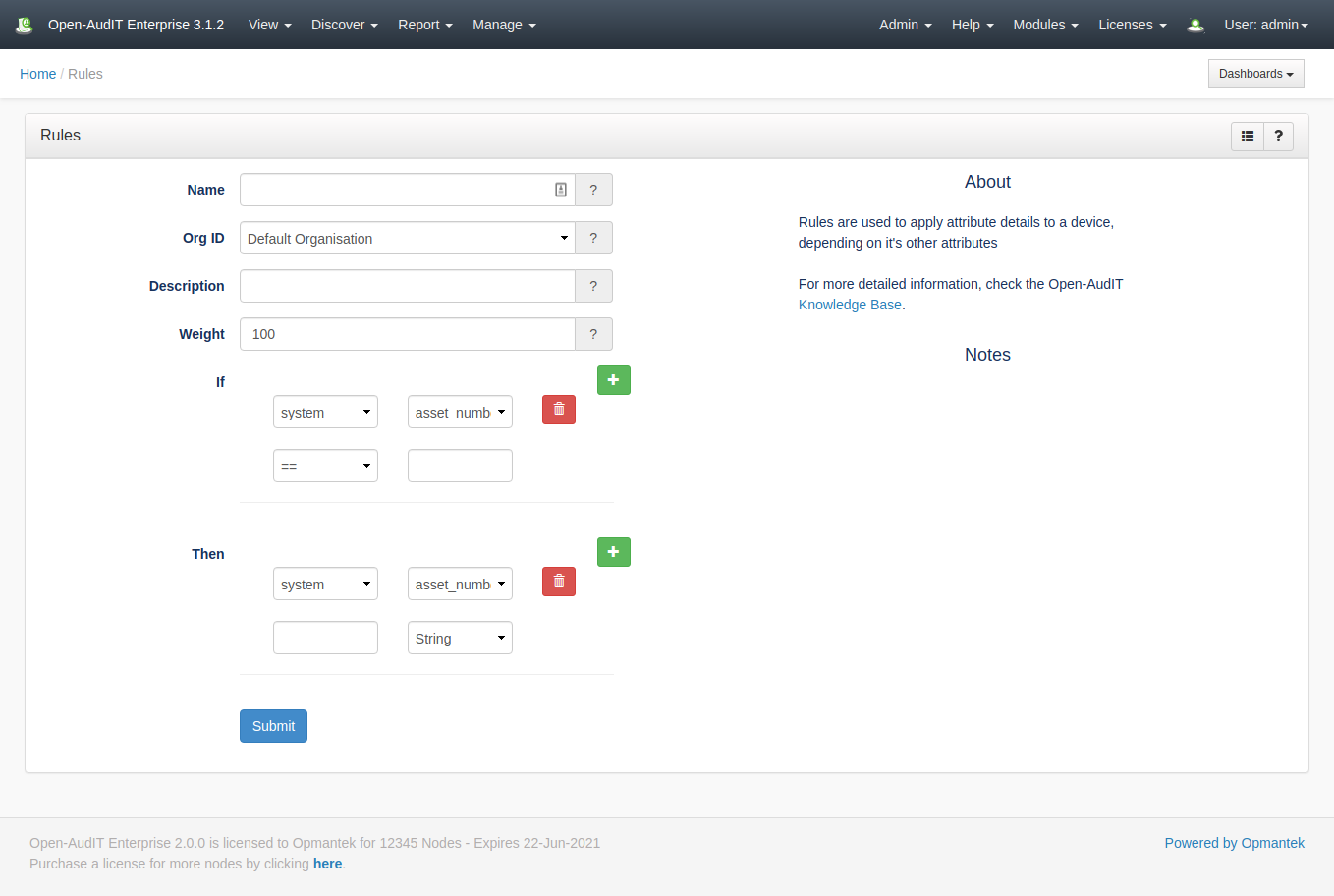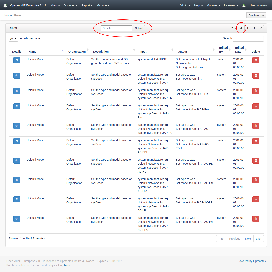...
NOTE - At present we cannot delete a rule input or output that contains a /. This is because the framework is parsing the / as part of the URL and returning a 404, even before our code runs. The work-around for this is to delete the Rule itslefitself, then recreate the inputs and outputs as required. Fortunately inputs and outputs that contain a / are rare (indeed, none exist by default).
...
Each time a device is discovered or an audit result is processed, all rules are retrieved from the database and run against the attributes of the specific device. Rules run against one device at a time - there is no facility to say "Run the rules against all devices" or "Run the rules against these devices". An individual rule will test one or more attributes of the device and if they match the rule, the result will be applied. Several attributes can be tested. Several attributes can be set. Think of this as an If This, Then That system for Open-AudIT.
Initially we have included rules for SNMP Enterprises, MAC Addresses, SNMP OIDs and quite a few custom rules. The actual counts are:
...
UPDATE - With the release of 3.2.2, we no longer store ~100,000 rules in the database. This was fine on my test device (a core i7, 16GB memory and Samsung 860 NVMe), but in practice was causing customers servers to choke.
As per the Release Notes for 3.2.2 -
So, that was a ride... In testing our new Rules feature worked a treat. In practice, not so much. Most servers (ie, not mine) can't cope with loading the rule set, even if we break it down to smaller chunks, when processing multiple devices. What to do? What to do? Well we've taken a small step back. Rules still exist as a feature, and they still work a treat. But instead of inserting 100,000 Rules into the database, we've split them up into four distinct files and implemented them as code only. Hence, no loading all 100,000 Rules, decoding JSON and running them against a device. Now we just load the files and run the statements. Much, much faster and more memory efficient. No load on MySQL, and hence the CPU also drops. No populating a massive record set and hence the memory drops. The not so good thing - these are no longer editable in the GUI. But it's not the end of the world. You can still make Rules as you see fit and they will be run after the "default" rules (those in code), hence you can override the "default" rules. So we don't lose much, but we gain a LOT of performance. We also added a few new Rules for Mac Models.
For those curious, the "new" files that replace the Rules are:
| File | Description |
|---|---|
| /open-audit/code_igniter/application/helpers/mac_helper | Matches MAC addresses to manufacturers. |
| /open-audit/code_igniter/application/helpers/mac_model_helper | Matches Apple manufacturer codes to models (stored in system.manufacturer_code). |
| /open-audit/code_igniter/application/helpers/snmp_model_helper | Matches the device's SNMP OID to a model and type. |
| /open-audit/code_igniter/application/helpers/snmp_model_helper | Matches the devices's SNMP OID to the manufacturer. |
And of course you are free to add or modify the rules as you see fit. If you have a device with an SNMP OID that doesn't match a model already in the database file - now you can add it easily. No more waiting for us to provide a patch and add it to the codebase code base for you.
When you create a Rules entry, you will need to provide a name and a list of inputs and outputs. The inputs and outputs are stored as JSON arrays within the database.
...
You can add and remove inputs and outputs as required.
Viewing Rules Details
...
Because there are so many rules (near one hundred thousand), paging through them is unrealistic. We still retrieve the default number of entries as per the configuration item, however there is a search box at the top of the panel. Use this to search through the name, description, inputs and outputs to refine the list and find what you're looking for. There is also a button on the panel header that will show you all the rules you have created or edited. See below.
Database Schema
| Code Block | ||||
|---|---|---|---|---|
| ||||
CREATE TABLE `rules` (
`id` int(10) unsigned NOT NULL AUTO_INCREMENT,
`name` varchar(200) NOT NULL DEFAULT '',
`org_id` int(10) unsigned NOT NULL DEFAULT '1',
`description` text NOT NULL,
`weight` int(10) unsigned NOT NULL DEFAULT '100',
`inputs` text NOT NULL,
`outputs` text NOT NULL,
`edited_by` varchar(200) NOT NULL DEFAULT '',
`edited_date` datetime NOT NULL DEFAULT '2000-01-01 00:00:00',
PRIMARY KEY (`id`)
) ENGINE=InnoDB AUTO_INCREMENT=155875 DEFAULT CHARSET=utf8 |
Example Database Entry
| Code Block | ||||
|---|---|---|---|---|
| ||||
id: 65554
name: Mac Address for Cisco Systems
org_id: 1
description: Set the manufacturer based on the MAC prefix.
weight: 90
inputs: [{"table":"network","attribute":"mac","operator":"st","value":"cc:46:d6"},{"table":"system","attribute":"manufacturer","operator":"eq","value":""}]
outputs: [{"table":"system","attribute":"manufacturer","value":"Cisco Systems","value_type":"string"}]
edited_by: system
edited_date: 2001-01-01 00:00:00 |
API / Web Access?
...
Database Schema
The database schema can be found in the application is the user has database::read permission by going to menu: Admin -> Database -> List Tables, then clicking on the details button for the table.
API / Web Access
You can access the collection using the normal Open-AudIT JSON based API. Just like any other collection. Please
...
see The Open-AudIT API documentation for further details.
API Routes
...
Request Method
...
ID
...
Action
...
Resulting Function
...
URL Example
...
Notes
...
Example Response
...
Default Items
Shipped are a set of default items. These can be found by going to menu: Help → Defaults → Rules
...
Web Application Routes
Only available under Open-AudIT Enterprise
...
Request Method
...
ID
...
Action
...
Resulting Function
...
URL Example
...
Notes
...
.



